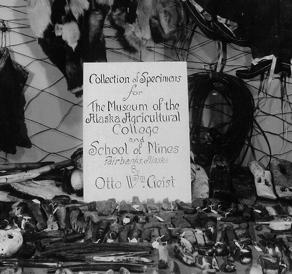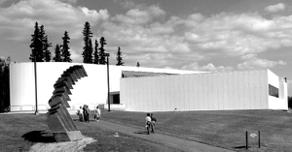Mission and History
Mission Statement
UAMN illuminates the natural history and cultural heritage of Alaska and the North through collections, research, education, and partnerships, and by creating a singular museum experience that honors diverse knowledge and respect for the land and its peoples.
Vision Statement
UAMN is an essential contributor to the well-being of the local and global community, an engaging gathering space, and a recognized resource and leader among circumpolar museums.
Core Values
- Preserving our shared cultural and natural history: We are committed to preserving collections in perpetuity to address present and future needs.
- Partnership: Collaboration with Indigenous, academic, agency, and other communities is central to our efforts.
- Integrity: We foster public trust through openness and ethical approaches to our research, education, and partnerships.
- Respect and Inclusivity: We are stronger when we honor diversity and are committed to making the museum economically, physically, culturally, and intellectually accessible to everyone.
- Engagement: We encourage curiosity, creativity, and lifelong learning through teaching, exhibitions, and programming.
(Approved October 26, 2022)
Museum History

The University of Alaska Museum has been around since the earliest days of the University
of Alaska. In 1926, at University President Charles Bunnell’s request, local naturalist
Otto Geist traveled throughout Alaska collecting ethnographic and archeological artifacts.
In 1929, the Museum invited the public to celebrate its grand opening, displaying
Geist's acquisitions and the University’s small painting collection. These items were
the University of Alaska Museum's first northern treasures.
After statehood, the Museum's growth followed waves of rapidly changing times in Alaska.
In 1961, the federally created Alaska Cooperative Wildlife Research Unit at the University
transferred its mammal, bird, and plant collections to the Museum. In 1970, the Museum
acquired existing fish and marine invertebrates collections, as well as the Institute
of Northern Forestry’s plant collection from the U.S. Forest Service. After the 1970s
pipeline boom, money flowed into the Museum to expand and diversify its art and ethnology
collections. In the 1980s, federal and state resource management legislation prompted
the collection of new natural and cultural history material from across Alaska. In
1991, the Museum created the Alaska Frozen Tissue Collection, a regional collection
of zoological materials supported by the National Science Foundation, the Alaska Department
of Fish & Game, the U.S. Fish & Wildlife Service, and others. In 1993, in compliance
with the Native American Graves and Repatriation Act, the Museum began the process
of returning human remains and other sensitive items from the Museum’s archeology
collection to Alaska Native villages across the state.

For more than 50 years, the Museum made its home on the University’s lower campus,
first on the top floor of the Eielson Building and then in Signers' Hall. In 1976,
the Friends of the University of Alaska Museum organized and actively petitioned Alaska
Governor Jay Hammond and the Legislature to appropriate funds for a new museum. With
their support, the current building opened in 1980. It was a bold architectural statement
for its time and was expected to be the first phase of a larger structure.
That larger structure opened in 2005, with a new wing doubling the size of the facilities
to 83,000 sq.ft. Designed by architect Joan Soranno and the GDM/HGA team, the signature
architecture of the new wing evokes images of glaciers, a diving whale's tail, the
prow of a ship, and other Alaska themes. Inside, expanded and renovated research labs,
exhibit galleries and educational facilities serve all aspects of the museum's mission.
Today, the Museum is the premier repository for artifacts and specimens collected
on state and federal lands in Alaska and a leader in northern natural and cultural
history research and education.
